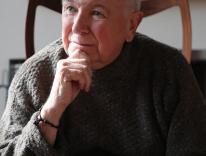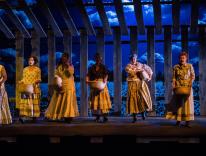Sometimes too much just isn’t enough. That was the only conclusion to draw from some of the wild flights of fancy that skidded to a landing on Broadway this spring. In an era when sure-bet revivals multiply like gerbils and producers frantically hedge their bets by casting celebrities (Ashley Judd in Cat on a Hot Tin Roof, anyone?), imaginative risk seems intrinsically admirable, so it was all the more disappointing when the long-awaited musical Bombay Dreams, a tribute to the over-the-top aesthetic of Indian “Bollywood” movies, turned out-bizarrely-to be a little thin.
How could this have happened? Well, a hint might come from another piece of exorbitant whimsy that opened around the same time: a revival of Tom Stoppard’s 1972 play Jumpers. Featuring murder, theology, a moon landing, an agnostic archbishop of Canterbury, and a team of philosophy professors who double as gymnasts, Jumpers should by all rights be another prodigal display of Stoppardian wit, like his recent Invention of Love. But while glutted with conceptual extravagance (we might mention the naked woman swinging from a chandelier), Jumpers lacks a few dramaturgical essentials, like suspense and a protagonist whose welfare is in jeopardy. It is hard to really care about the characters in this handsome National Theatre production, directed by David Leveaux and designed by Vicki Mortimer with snazzy visual echoes of the lunar theme (curvy furniture, a disco ball, etc.). The excellent actor Simon Russell Beale waffles on deliciously as the mild-mannered philosopher George, who’s toiling over a paper on the existence of God, but the character’s windy metaphysics early in Act I (“To ask, ‘Is God?’ appears to presuppose the existence of a deity who, perhaps, isn’t...”) dissipates the play’s narrative momentum, as does George’s dispassionate rapport with his blonde-bombshell wife Dorothy (Essie Davis).
In short, Jumpers shoots off Stoppardian pyrotechnics without building a sturdy play to catch them in. A similar nuts-and-bolts problem mars Bombay Dreams, a musical spicily scored by the Bollywood composer A. R. Rahman, who has sold 200 million albums worldwide. Bombay Dreams boasts an exotic setting (Bombay); ebullient choreography (by Anthony Van Laast and Farah Khan); lyrics by Don Black (whose credits include several James Bond theme songs); and characters as flat as paper. Or perhaps it would be more appropriate to say “as flat as nylon,” because textiles are the real star of this show. The swirling red saris; the lengths of saffron shawl; the gold tassels, white spangles, glittery beaded bodices-observing the brilliant color, lavishness, and sheer quantity of the costumes (which Thompson also designed) makes one wish the producers had removed some money from the fabric budget and used it to spruce up the clunky book (by Thomas Meehan, co-writer of The Producers, and Meera Syal).
Instead, the clothes, and the Taj Mahal pageantry of Thompson’s sets-movie-set temples, a real fountain, a billboard-encrusted slab of Bombay slum-bedeck a cliché-ridden narrative about an impoverished youth, Akaash (Manu Narayan), who lucks into a career as a movie idol, loses his values, and gets them all back again. His romances, with a bratty diva (Ayesha Dharker) and an earnest director (Anisha Nagarajan) exhibit all the naturalness of a slab of wallboard, and a perfunctory sentimentality governs his rapport with his friends from the slums. To make matters worse, the show’s dialogue features implausible lines like “Bombay is a rat race, and I had to mix with the vermin!” And since the fantastical world of Bollywood movies is evoked only in passing, it’s hard to see Bombay Dreams as anything but a missed opportunity.
After all, wild theatrical conceits-ideas as far-fetched as the aesthetic of a Bollywood film-can make stunning theater: witness the Roundabout Theatre Company’s mounting of Stephen Sondheim and John Weidman’s Assassins. This dark, brilliant musical explores an eerie landscape that might be a Secret Service agent’s concept of hell: an assembly of the men and women who’ve tried to murder U.S. presidents. Here, more desperately unhinged than ever, are killers and would-be killers, from John Wilkes Booth, Lincoln’s nemesis; to John Hinckley, whose crazed infatuation for Jodie Foster led him to shoot Ronald Reagan in 1981. They have gathered at a seedy fairground where one arcade game-a shooting gallery-offers the prospect of assassinating America’s top politician.
For a certain type of individual, the attraction is irresistible. “Hey, pal-feelin’ blue?” the fairground’s proprietor sings at the start of the show, “Don’t know what to do?...C’mere and kill a president.” Sondheim and book-writer Weidman’s touch of genius is to posit that this sinister amusement park is, in some way, a version of the American Dream. The values our society has treasured-liberty; individualism; equality; the autonomy of the press, which indirectly fosters a culture of celebrity-are the very values that molded Lee Harvey Oswald and his fellow desperados. Assassins drives this point home via the richly textured score, an ironic pastiche of upbeat American musical genres (marching-band tunes, carousel melodies, bright ballet-friendly sonorities à la Aaron Copland) subverted with dissonance and minor keys. The United States promises its residents the freedom to achieve and to choose, the music reminds us, and some residents choose fame at the end of a rifle.
Assassins had a brief run at New York’s Playwrights Horizons in 1991, but the show has never before reached Broadway; the revival the Roundabout had scheduled for 2001 was postponed in the wake of the September 11 attacks. Time seems only to have burnished the musical’s chances: Joe Mantello has crafted a mesmerizing production, lucid and sinister, and populated by theatrical aristocrats like Neil Patrick Harris (who played Doogie Howser on television). Of particular note are the loudmouthed comedian Mario Cantone as Samuel Byck (who tried to hijack a jetliner and crash it into Nixon’s White House, in 1974), and the extraordinary Denis O’Hare, as Charles Guiteau, who slew James Garfield in 1881. O’Hare portrays Guiteau as a crazed oddball, with a lisp and childish mannerisms, like the way he flourishes a book of theology he published, smacking the volume against his palm. In one especially memorable scene recreating Guiteau’s walk to the gallows, O’Hare dances up a staircase, warbling a ballad.
Designer Robert Brill has set the assassins’ fairground beneath a ramshackle dome-shaped scaffold, which the staircase ascends and which, at least one critic has noted, resembles the underside of a roller coaster. But the scaffold also looks like a half-built hall, and as Assassins unfolds, its deconstruction of American optimism explains the imagery. Sondheim’s parable is set in a fanciful limbo, where a pot shot at the president can score you a stuffed animal, but this carnival is really not remote from our daily lives. Our gospel of freedom and opportunity produces these assassins. The dome is half-built because we’re constructing it ourselves.
Please email comments to [email protected] and join the conversation on our Facebook page.
Previous Story
Still, We Believe: The Boston Red Sox Movie
Next Story
Summer Reading

